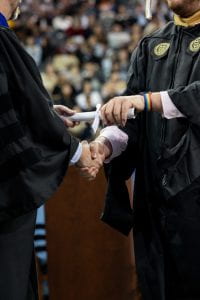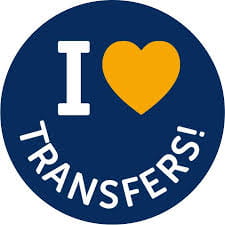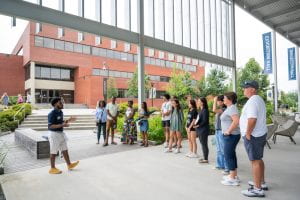This week we welcome Interim Executive Director of Admission, Mary Tipton Woolley, to the blog. Welcome, Mary Tipton!
Over the last several years, the Georgia Tech Admission Blog has allowed us to share our knowledge and expertise with a wide audience. As loyal readers know, the main author of the blog, Rick Clark, moved into a new role at Georgia Tech in January.
 Before the summer begins, we want to take a moment to reflect on the greatest hits over the last eight years – think of it as a Spotify wrapped for the history of the blog!
Before the summer begins, we want to take a moment to reflect on the greatest hits over the last eight years – think of it as a Spotify wrapped for the history of the blog!
The blog started in the fall of 2015, so we’ll start our recap in 2016. These top blog posts for each year are evergreen and many continue to reign as some of our most read blogs of all time.
2016 – The year of Brexit and the Cubs winning the World Series for the first time in over 100 years also saw the publication of one of our top blogs of ALL TIME, 25 Reasons YOU SHOULD NOT Apply to Georgia Tech. Since then, first-year applications to Georgia Tech have grown 96%, proving that telling people what they shouldn’t do means they will do just that!
2017 – If you missed the first total solar eclipse in nearly 100 years in August, you may have agreed with the sentiment expressed in the top blog of 2017, Ad(mission): It’s not fair.
2018 – In the same year Rick decreed that listening is That ONE Thing that is most important in the admission process, Drake was the most listened to artist on Spotify.
2019 – The top blog of 2019 had a funny name but continues to be one of our most popular blogs of all time – Will saying I’m a blueberry get me into college? Supplemental Essays 101. Did you know that Georgia, aka the Peach State, actually produces more blueberries than peaches?
2020 – The top blog of 2020, What does being deferred mean? didn’t come until December – maybe because we had other things on our mind that year?
2021 – In 2021, many of us waited impatiently for life to return its pre-pandemic normalcy. With waiting on our minds, it makes sense that the top blog of this year was all about the waitlist – The Waitlist. Why?!
2022 – The unveiling of the first image from the James Webb telescope in July 2022 proved that man will go to incredible lengths to understand space, so why not continue to ask what requirements it takes to get into a college? What Are Your Admission Requirements addresses this continuous quest for admission knowledge.
2023 – This year brought the summer of “Barbenheimer” at the box office and The Two Most Important Letters in College Admission as the most popular blog of the year.
The world of college admission can often seem like an ever-changing landscape. Because of that, we are committed to reflection and critical thinking about the content we provide to you and have decided to pause the blog this summer to do just that.
You can expect us back here in August with a variety of writers from our team focusing a bit more on Georgia Tech specific content. We are hopeful this blog will continue to be a resource students, supporters and counselors can utilize in their daily work.
We hope you all have a great summer. We can’t wait to connect with you again soon!

 Typically, you’ll see universities talk about ROI in terms of mean or median annual income of recent graduates. However, I like to caution that ROI means different things for different people. Going back to
Typically, you’ll see universities talk about ROI in terms of mean or median annual income of recent graduates. However, I like to caution that ROI means different things for different people. Going back to  The number one piece of advice from the current students I spoke to was to make a plan – whether that be three months, three days, or three years before starting college.
The number one piece of advice from the current students I spoke to was to make a plan – whether that be three months, three days, or three years before starting college. Many college and university presidents are actively thinking of ways to recruit you to their campus. That’s the very reason some colleges and universities have staff dedicated to transfer students. Institutions with dedicated transfer staff place considerable importance on transfer students.
Many college and university presidents are actively thinking of ways to recruit you to their campus. That’s the very reason some colleges and universities have staff dedicated to transfer students. Institutions with dedicated transfer staff place considerable importance on transfer students. Do not be afraid to reach out to institutions of interest. Attend a
Do not be afraid to reach out to institutions of interest. Attend a  LaSean Price has supported transfer students in many roles throughout her time in higher education. She joined Georgia Tech in 2019 and currently coordinates Tech’s Transfer Pathway Programs and leads admission staff in file review of transfer applicants. Having experienced the transfer process firsthand, she demonstrates a strong commitment to advocating for, supporting, and collaborating with transfer champions across campus.
LaSean Price has supported transfer students in many roles throughout her time in higher education. She joined Georgia Tech in 2019 and currently coordinates Tech’s Transfer Pathway Programs and leads admission staff in file review of transfer applicants. Having experienced the transfer process firsthand, she demonstrates a strong commitment to advocating for, supporting, and collaborating with transfer champions across campus. Campus tour guides are only one person and they share generally about most programs on their campus. Your tour guide is going to share information about the overall student experience on their campus, and many times their experiences are going to be similar to other majors.
Campus tour guides are only one person and they share generally about most programs on their campus. Your tour guide is going to share information about the overall student experience on their campus, and many times their experiences are going to be similar to other majors.
 Andrew Cohen joined Georgia Tech in 2018 and currently oversees the guest experience for all Undergraduate Admission visitors. His love for providing visitors with informative, authentic, and personal experiences started as a student tour guide at his alma mater, Ithaca College. Andrew’s passion for the visit experience has led him to his involvement in the Collegiate Information and Visitor Services Association, where he currently services as the President-Elect on their executive board.
Andrew Cohen joined Georgia Tech in 2018 and currently oversees the guest experience for all Undergraduate Admission visitors. His love for providing visitors with informative, authentic, and personal experiences started as a student tour guide at his alma mater, Ithaca College. Andrew’s passion for the visit experience has led him to his involvement in the Collegiate Information and Visitor Services Association, where he currently services as the President-Elect on their executive board. While well appointed, the room was small and since my husband had forgotten his CPAP machine at home (queue sound effects), none of us had gotten much sleep the night before (nor did we the entire time). Tensions on the set were running high and the constant questions I peppered my college-bound daughter with (“Did you get your room pin?” “Do you know where we need to park?” “How long do we have to actually move in?” “Do they have carts or dollies?”) were soon met with an 18-year old’s wrath, which includes rolling eyes and deep exasperated breaths that started in her toes and rumbled through her rib cage … Stanislavski would be proud!
While well appointed, the room was small and since my husband had forgotten his CPAP machine at home (queue sound effects), none of us had gotten much sleep the night before (nor did we the entire time). Tensions on the set were running high and the constant questions I peppered my college-bound daughter with (“Did you get your room pin?” “Do you know where we need to park?” “How long do we have to actually move in?” “Do they have carts or dollies?”) were soon met with an 18-year old’s wrath, which includes rolling eyes and deep exasperated breaths that started in her toes and rumbled through her rib cage … Stanislavski would be proud! The Director had envisioned this final scene in her mind in the weeks leading up to our departure. I would hold it together, share a sage word or two of final wisdom, pull out a starched, lace handkerchief (or Kleenex, probably easier) to dab at that tear on my cheek, hug the main character close, wish her well, offer a loving goodbye and then drive off down the tree-lined, college lane.
The Director had envisioned this final scene in her mind in the weeks leading up to our departure. I would hold it together, share a sage word or two of final wisdom, pull out a starched, lace handkerchief (or Kleenex, probably easier) to dab at that tear on my cheek, hug the main character close, wish her well, offer a loving goodbye and then drive off down the tree-lined, college lane. Kathleen Voss has worked in college admission for over 25 years. She joined the Georgia Tech Office of Undergraduate Admission in 2013 as the Institute’s first Regional Director of Admission. Prior to Tech, Kathleen worked regionally for Manhattan College and as the Associate Director of Admission for Regis College in Massachusetts. She is a member of
Kathleen Voss has worked in college admission for over 25 years. She joined the Georgia Tech Office of Undergraduate Admission in 2013 as the Institute’s first Regional Director of Admission. Prior to Tech, Kathleen worked regionally for Manhattan College and as the Associate Director of Admission for Regis College in Massachusetts. She is a member of